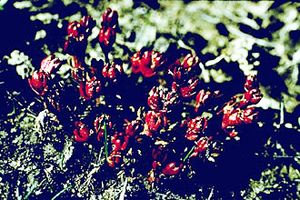Tinytim facts for kids
Quick facts for kids Tinytim |
|
|---|---|
 |
|
| Conservation status | |
| Scientific classification | |
| Genus: |
Geocarpon
|
| Species: |
minimum
|
Geocarpon minimum is a very small flowering plant. It is often called tinytim or earth-fruit because of its size. This plant is the only species in its group, called Geocarpon. It belongs to the Caryophyllaceae family, which also includes carnations.
The tinytim plant is very rare. It is found in only about 34 places in the US states of Arkansas, Louisiana, Missouri, and Texas. Because it is so rare, it was listed as a threatened species in the United States in 1987. This means it needs protection to survive.
Contents
Where Tinytim Lives
Most tinytim plants live in Missouri. Some are also found in Arkansas and Louisiana. In 2004, it was even discovered in Anderson County, Texas. Scientists believe this plant used to be found in many more places across North America. But as the climate changed, it could only survive in a few special spots.
Tinytim's Special Home
This plant needs a very specific kind of home. It grows on sandstone glades and rocky areas. These places often have bare soil with lots of magnesium and sodium salts. Sometimes, it grows on "slicks." These are areas covered with lichens and tiny green things called Nostoc cyanobacteria. After winter rains, these slicks get very wet. Then, they dry into a hard crust. Not many other plants can grow in such a tough environment.
The Life Cycle of Tinytim
The tinytim plant is an ephemeral species. This means it grows, flowers, and produces seeds very quickly. Its whole life cycle usually happens within four weeks. This often takes place around February and March. In some areas, it might grow as late as June.
The number of tinytim plants each year depends on the rain. If there isn't much rain, you might see very few plants, or none at all. But after a wet season, thousands of these tiny plants can appear!
What Tinytim Looks Like
Geocarpon minimum is a very small succulent plant. It grows no taller than 4 centimeters (about 1.6 inches). Its stem is as thin as a hair. When it first sprouts, it can be grayish, brownish, or green. As it gets older, it changes color. It can turn magenta, red, bright pink, or purplish. This red color comes from special pigments called anthocyanins.
Its leaves are tiny, only 3 or 4 millimeters long. It has a red or purplish flower cluster, called an inflorescence. Each flower is also very small, no more than 4 millimeters long.
Why Tinytim Needs Help
The special places where tinytim lives, like the slicks and salty prairies, are becoming rare. The soil in these areas can change. When the soil becomes better for other plants, the tinytim struggles. Other plants easily outcompete it.
Scientists are not sure exactly why the soil changes. These special habitats might need some kind of natural event, like fire, to stay bare and salty. But too much disturbance can also harm the habitat. For example, cattle grazing can change the soil. Sometimes, it helps other plants grow, turning bare spots into prairie. But in other cases, heavy grazing can keep bigger plants down, allowing tinytim to grow. Even Off-road vehicles can destroy habitat. However, the way they disturb the ground might also help keep the soil bare. More research is needed to understand how tinytim interacts with its environment.
Looking to the Future
Even though tinytim is still rare, it has a "high recovery potential." This means it has a good chance of recovering. It might even be removed from the endangered species list soon! Since it was first listed, more groups of tinytim plants have been found. Some new plants have also been planted in suitable areas.
However, these plant groups need to be watched carefully to make sure they survive. Scientists also need to study the genetic variability of the species. This will help them understand how different tinytim plants are from each other across their range.
Images for kids
See also
 In Spanish: Geocarpon minimum para niños
In Spanish: Geocarpon minimum para niños



